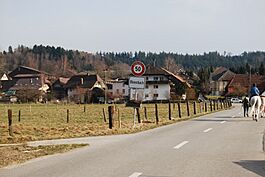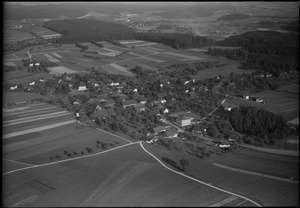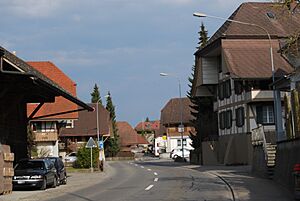Bleienbach facts for kids
Quick facts for kids
Bleienbach
|
||
|---|---|---|

The entrance to Bleienbach village
|
||
|
||
| Country | Switzerland | |
| Canton | Bern | |
| District | Oberaargau | |
| Area | ||
| • Total | 5.69 km2 (2.20 sq mi) | |
| Elevation | 483 m (1,585 ft) | |
| Population
(Dec 2020 )
|
||
| • Total | 734 | |
| • Density | 129.00/km2 (334.1/sq mi) | |
| Postal code |
3368
|
|
| Surrounded by | Langenthal, Lotzwil, Ochlenberg, Rütschelen, Thörigen, Thunstetten | |
Bleienbach is a small town, also called a municipality, located in the Oberaargau administrative district. This area is part of the canton of Bern in Switzerland. It's a quiet place with a long history.
Contents
History of Bleienbach
Bleienbach was first mentioned in old records in the year 1194. Back then, it was known as Blaichinbach.
Early Settlements and Old Churches
People have lived near Bleienbach for a very long time. Archaeologists found an ancient burial mound from the Hallstatt culture in a nearby area called Oberbützberg. They also found an old fortress from the Middle Ages in Eggwald forest. An old road near the village church shows that this area has been important for centuries.
The village church has a long history too. The first church was likely made of wood, built around the 8th or 9th century. Later, a stone church was built in the 9th or 10th century. This stone church was mentioned in records from 1194. It was replaced by another church in the 13th century. The church building you see today was built much later, between 1732 and 1734.
How Bleienbach Became Part of Bern
In the past, important rights over the village, like choosing priests for the church, belonged to powerful families. In 1331, a man named Johann of Aarwangen bought some of these rights. Later, in 1432, some rights went to the city of Bern. The rest followed in 1443 or 1455. Once Bern controlled the village, Bleienbach became part of the Aarwangen area. In 1826, a big fire destroyed the center of the village, but it was quickly rebuilt.
Economy and Modern Changes
For a long time, people in Bleienbach mostly worked in farming. In the 1700s and 1800s, many families also wove cloth at home to earn extra money. Because Bleienbach is close to the larger Langenthal region, it didn't develop many big factories itself. Instead, many people from Bleienbach traveled to work in factories in Langenthal. In 1935, a private airstrip for people who enjoy flying opened just outside the village.
Geography of Bleienbach
Bleienbach covers an area of about 5.7 square kilometers (2.2 square miles). A large part of this land, about 57.1%, is used for farming. Forests cover about 33% of the area. The rest of the land, about 8.3%, has buildings or roads. A small part, about 1.6%, is made up of rivers or lakes.
Most of the built-up areas are homes and other buildings. Roads and other transportation areas make up a smaller part. The forests are mostly dense, thick woods. For farming, people grow crops on about 41.1% of the land. Another 14.6% is used for pastures where animals graze. A small amount, 1.4%, is used for orchards or growing grapes.
The municipality of Bleienbach includes the main village of Bleienbach and a smaller settlement called Oberbützberg. A "hamlet" is a very small village or group of houses.
What is the Coat of Arms?
A coat of arms is a special symbol or design that represents a family, a city, or a region. Bleienbach's coat of arms shows a black background with a silver fish and a green clover leaf at the bottom. On the other side, it has a silver background with a black bar. This design might be a "canting arms" which means the picture hints at the name. The German word Blei is a type of fish, like a Bream, which is shown on the coat of arms.
Population and People
Bleienbach has a population of about 700 people. In 2010, about 5.2% of the people living there were from other countries. Over the past ten years (2000-2010), the number of people living in Bleienbach has gone down a little.
Languages Spoken in Bleienbach
Most people in Bleienbach speak German as their main language. In 2000, about 95.7% of the population spoke German. A smaller number of people spoke Serbo-Croatian or French. There were also a few people who spoke Italian.
Where People Live and Come From
In 2000, about 36.7% of the people living in Bleienbach were born there. Another 41.1% were born in the same canton (Bern). About 14.1% were born somewhere else in Switzerland, and 6.5% were born outside of Switzerland.
Age Groups in Bleienbach
In 2010, children and teenagers (up to 19 years old) made up about 16.3% of the population. Adults (20 to 64 years old) were the largest group, making up 65.6%. Seniors (over 64 years old) made up 18% of the population.
Historical Population Trends
The chart below shows how the population of Bleienbach has changed over many years:

Economy and Jobs
In 2011, the unemployment rate in Bleienbach was very low, at 0.56%. This means almost everyone who wanted a job had one. In 2008, there were 646 people working in the municipality.
Types of Jobs in Bleienbach
Jobs are often grouped into three main types:
- Primary sector: These jobs involve getting raw materials from nature, like farming or forestry. In Bleienbach, 51 people worked in this sector, mostly in agriculture.
- Secondary sector: These jobs involve making things, like in factories or construction. In Bleienbach, 431 people worked in this sector, mostly in manufacturing.
- Tertiary sector: These jobs involve providing services, like teaching, healthcare, or working in shops. In Bleienbach, 164 people worked in this sector.
In 2008, there were 569 full-time equivalent jobs. This means if you add up all the hours worked by part-time and full-time employees, it would be like having 569 full-time workers. Most of these jobs were in manufacturing. Other service jobs included sales, transportation, hotels, restaurants, and healthcare.
Commuting to Work
In 2000, many people traveled into Bleienbach for work (527 workers). Fewer people traveled out of Bleienbach to work elsewhere (252 workers). This means Bleienbach has more jobs than local workers. About 7.8% of workers used public transportation, and 56% used a private car to get to work.
Religion in Bleienbach
Based on a census in 2000, most people in Bleienbach belonged to the Swiss Reformed Church (about 80.2%). A smaller number, about 10.1%, were Roman Catholic. There were also people who belonged to other Christian churches, and a few who were Islamic. About 5.4% of the population did not belong to any church.
Education in Bleienbach
In Switzerland, the school system is set up by each canton. In the Canton of Bern, children usually start with one year of non-required Kindergarten. After that, they go to six years of Primary school. Then, they have three years of lower Secondary school. In secondary school, students are placed into different classes based on their abilities. After lower secondary, students can choose to continue their education or start an apprenticeship to learn a trade.
In 2000, about 43.1% of the people in Bleienbach had finished high school (upper secondary education). About 10% had gone on to higher education, like a university or a specialized college.
During the 2009-2010 school year, 44 students attended classes in Bleienbach. There was one kindergarten class with 7 students. The municipality also had two primary classes with 37 students.
Important Sites
The entire village of Bleienbach is recognized as an important Swiss Heritage Site. This means it has special historical or cultural value that should be protected.
See also
 In Spanish: Bleienbach para niños
In Spanish: Bleienbach para niños







